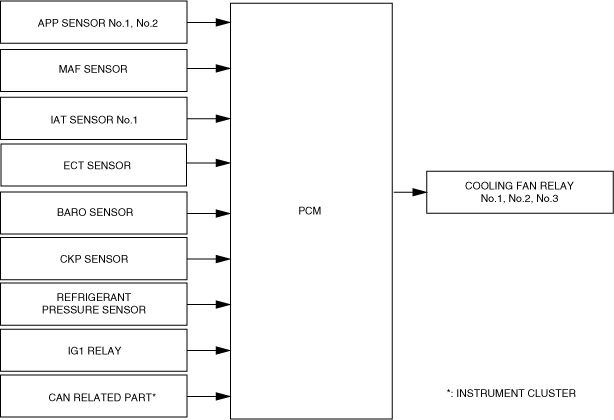ELECTRICAL FAN CONTROL [WITH CYLINDER DEACTIVATION (SKYACTIV-G 2.0, SKYACTIV-G 2.5)]
id0140m2205000
Outline
• Through cooling of the radiator and condenser by operation of the cooling fan according to vehicle conditions, engine reliability and cooling performance have been improved.
Block Diagram
Operation
• The PCM determines the demand airflow volume by the following conditions.
Operation Pattern
|
Demand airflow volume
|
Cooling fan relay
|
Cooling fan motor
|
|
No.1
|
No.2/No.3
|
No.1
|
No.2
|
|
No airflow
|
OFF
|
OFF
|
Stop
|
Stop
|
|
Small
|
ON
|
OFF
|
Low-speed
|
Low-speed
|
|
Large
|
ON
|
ON
|
High-speed
|
High-speed
|
Engine coolant temperature condition
-
• Changes the demand airflow volume according to the engine coolant temperature.
• To suppress overheating, the cooling fan is operated when the engine coolant temperature is high. The demand airflow volume is large or small depending on the engine coolant temperature.
-
• If high-load driving continues with low wind blowing against the vehicle, air bubbles in the fuel line could occur by the rise in the fuel temperature from the heat of the engine. To prevent poor engine starting performance by air trapped in the fuel line from the occurrence of air bubbles, if the following conditions are met, the PCM operates the cooling fan (Demand airflow volume: Low).
• To suppress overheating, the cooling fan is operated when the engine coolant temperature is high. The demand airflow volume is large or small depending on the engine coolant temperature.
A/C operation condition
-
• Controls the demand airflow volume depending on the refrigerant pressure and vehicle speed when the A/C switch is on.
|
Vehicle speed
|
Refrigerant pressure
|
|
1.3 MPa {13 kgf/cm2, 189 psi} or less
|
1.3 MPa {13 kgf/cm2, 189 psi} or more
|
1.5 MPa {15 kgf/cm2, 217 psi} or more
|
2.2 MPa {22 kgf/cm2, 319 psi} or more
|
|
45 km/h {28 mph} or less
|
Small
|
Small
|
Large
|
Large
|
|
45 km/h {28 mph} or more
|
No airflow
|
Small
|
Large
|
Large
|
|
65 km/h {40 mph} or more
|
No airflow
|
Small
|
Small
|
Large
|
|
85 km/h {53 mph} or more
|
No airflow
|
No airflow
|
No airflow
|
Large
|
After Cooling Control
-
• If the engine is stopped after continuous high-load driving (vehicle is driven at 25 km/h {16 mph} or more within 4 min before stopping the engine), the engine heat may cause the fuel temperature to increase and air bubbles may occur in the fuel line. To prevent the occurrence of air bubbles which could lead to poor engine startability due to trapped air, the PCM operates the cooling fan (airflow volume demand: Low) for 4.5 min (maximum of 7.5 min if the engine coolant temperature is 94 °C {201 °F} or more) when the following conditions are met.
-
― Engine coolant temperature: 81 °C {178 °F} or more
― Accumulated heat in engine compartment is extremely high
Conditions during collision
-
• If a collision signal from the SAS control module is received, the PCM stops the engine cooling fan to avoid use of battery voltage.
